
Answer
372k+ views
Hint: The different arrangement of the atoms of a molecule in space is termed as isomers. The term isomer is inspired from the Greek language in which it means as iso as same ane mers as parts. The credit for the discovery and the development of isomerism goes to J. Von Liebig of Germany in 1823.
Complete answer: Isomers are classified into structural isomers and stereoisomers.
Structural isomers are further classified into ionisation isomerism, solvent or hydrate isomerism, linkage isomerism, coordination isomerism, coordination position isomerism, and polymerisation isomerism.
Stereo isomers are further classified into geometrical isomers which are further classified into cis, trans, facial and meridonial isomers, and the optical isomers.
The optical isomers are of three types as (i) $[M\,{(AA)_3}\,]$ type with example as ${[Co{(en)_3}]^{3 + }}$ . (ii) $[M\,{(AA)_2}{B_2}\,]$ or $[M\,{(AA)_2}BC\,]$ type with example as $[CoC{l_2}{(en)_2}]$ . and (iii) $[M\,(AA){B_2}{C_2}\,]$ type with example as $[Co(en){(N{H_3})_2}C{l_2}]$ .
The most important criteria for a molecule to be optically active is the prosperity of the chirality. But chirality does not only mean different atoms attached to the central atom. For a molecule to be chiral, there should be absence of all the elements of symmetry.
If a molecule lacks elements of symmetry, the formula to calculate the optical isomer is ${2^n}^{ - 1}$ . $\forall \,n$ is the total number of chiral carbons.
(A). $C{H_3}CH(OH)COOH$ the total number of chiral carbons is one. So putting the numbers of chiral carbons present in formula ${2^n}^{ - 1}$ $ \Rightarrow {2^1}^{ - 1} \Rightarrow {2^0} \Rightarrow 1$. Thus only one optical isomer exists.
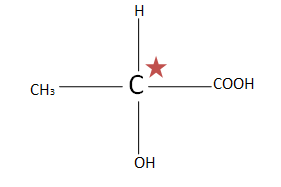
(B). $HOOC{(CHOH)_2}COOH$ as the plane of symmetry is present, there is no optical isomer present.
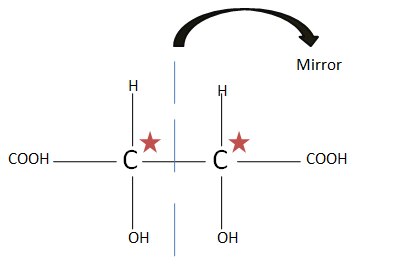
(C). $HOOC{(CHOH)_3}COOH$ the total number of chiral carbons is three. So putting the numbers of chiral carbons present in formula ${2^n}^{ - 1}$ $ \Rightarrow {2^3}^{ - 1} \Rightarrow {2^2} \Rightarrow 4$
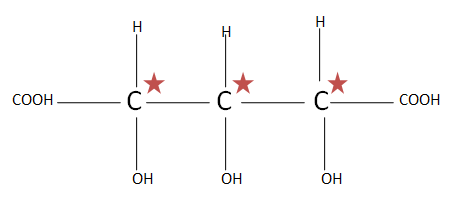
(D). ${H_3}C{(CHOH)_2}COOH$ the total number of chiral carbons is two. So putting the numbers of chiral carbons present in formula ${2^n}^{ - 1}$ $ \Rightarrow {2^2}^{ - 1} \Rightarrow {2^1} \Rightarrow 2$
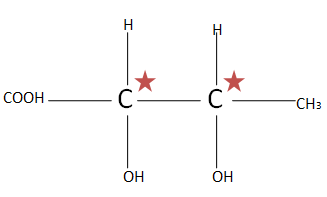
(E). $C{H_3}CH(Br)CH(Br)COOH$ the total number of chiral carbons is two. So putting the numbers of chiral carbons present in formula ${2^n}^{ - 1}$ $ \Rightarrow {2^2}^{ - 1} \Rightarrow {2^1} \Rightarrow 2$
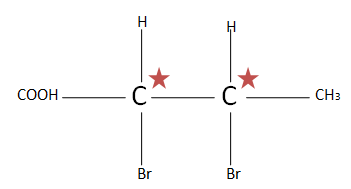
Note:
The elements of symmetry are (i) Axis of symmetry, (ii) Plane of symmetry, (iii) Improper axis of symmetry, (iv) Inversion. Iff any of the symmetric elements is present, then that molecule is considered to be achiral and does not possess optical activity.
Complete answer: Isomers are classified into structural isomers and stereoisomers.
Structural isomers are further classified into ionisation isomerism, solvent or hydrate isomerism, linkage isomerism, coordination isomerism, coordination position isomerism, and polymerisation isomerism.
Stereo isomers are further classified into geometrical isomers which are further classified into cis, trans, facial and meridonial isomers, and the optical isomers.
The optical isomers are of three types as (i) $[M\,{(AA)_3}\,]$ type with example as ${[Co{(en)_3}]^{3 + }}$ . (ii) $[M\,{(AA)_2}{B_2}\,]$ or $[M\,{(AA)_2}BC\,]$ type with example as $[CoC{l_2}{(en)_2}]$ . and (iii) $[M\,(AA){B_2}{C_2}\,]$ type with example as $[Co(en){(N{H_3})_2}C{l_2}]$ .
The most important criteria for a molecule to be optically active is the prosperity of the chirality. But chirality does not only mean different atoms attached to the central atom. For a molecule to be chiral, there should be absence of all the elements of symmetry.
If a molecule lacks elements of symmetry, the formula to calculate the optical isomer is ${2^n}^{ - 1}$ . $\forall \,n$ is the total number of chiral carbons.
(A). $C{H_3}CH(OH)COOH$ the total number of chiral carbons is one. So putting the numbers of chiral carbons present in formula ${2^n}^{ - 1}$ $ \Rightarrow {2^1}^{ - 1} \Rightarrow {2^0} \Rightarrow 1$. Thus only one optical isomer exists.

(B). $HOOC{(CHOH)_2}COOH$ as the plane of symmetry is present, there is no optical isomer present.

(C). $HOOC{(CHOH)_3}COOH$ the total number of chiral carbons is three. So putting the numbers of chiral carbons present in formula ${2^n}^{ - 1}$ $ \Rightarrow {2^3}^{ - 1} \Rightarrow {2^2} \Rightarrow 4$

(D). ${H_3}C{(CHOH)_2}COOH$ the total number of chiral carbons is two. So putting the numbers of chiral carbons present in formula ${2^n}^{ - 1}$ $ \Rightarrow {2^2}^{ - 1} \Rightarrow {2^1} \Rightarrow 2$

(E). $C{H_3}CH(Br)CH(Br)COOH$ the total number of chiral carbons is two. So putting the numbers of chiral carbons present in formula ${2^n}^{ - 1}$ $ \Rightarrow {2^2}^{ - 1} \Rightarrow {2^1} \Rightarrow 2$

Note:
The elements of symmetry are (i) Axis of symmetry, (ii) Plane of symmetry, (iii) Improper axis of symmetry, (iv) Inversion. Iff any of the symmetric elements is present, then that molecule is considered to be achiral and does not possess optical activity.
Recently Updated Pages
what is the correct chronological order of the following class 10 social science CBSE

Which of the following was not the actual cause for class 10 social science CBSE

Which of the following statements is not correct A class 10 social science CBSE

Which of the following leaders was not present in the class 10 social science CBSE

Garampani Sanctuary is located at A Diphu Assam B Gangtok class 10 social science CBSE

Which one of the following places is not covered by class 10 social science CBSE

Trending doubts
Derive an expression for drift velocity of free electrons class 12 physics CBSE

Which are the Top 10 Largest Countries of the World?

Write down 5 differences between Ntype and Ptype s class 11 physics CBSE

The energy of a charged conductor is given by the expression class 12 physics CBSE

Fill the blanks with the suitable prepositions 1 The class 9 english CBSE

Derive an expression for electric field intensity due class 12 physics CBSE

How do you graph the function fx 4x class 9 maths CBSE

The Equation xxx + 2 is Satisfied when x is Equal to Class 10 Maths

Derive an expression for electric potential at point class 12 physics CBSE



